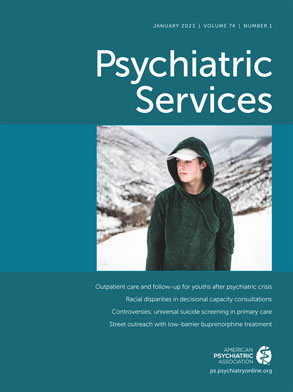Drug-related deaths are overrepresented in homeless communities, and most are opioid related. Buprenorphine is a lifesaving medication for opioid use disorder that can be prescribed to unsheltered patients by street medicine providers. However, few patients experiencing homelessness have access to street-based buprenorphine treatment services.
The Connecticut Mental Health Center (CMHC) is an urban community mental health center in New Haven. In 2016, CMHC initiated “boots-on-the-ground” street outreach to provide care to the city’s estimated 673 unsheltered individuals. The street psychiatry program was launched in July 2019. The team includes a full-time psychiatrist, a licensed clinical social worker, a recovery coach with lived experience of addiction and homelessness, a program manager, and rotating trainees. The team’s mission is to offer New Haven’s street-dwelling communities assertive, compassionate, and nonjudgmental mental health care centered on harm-reduction values.
From July 2019 to April 2021, the street psychiatry team had 475 encounters with 145 individuals. Providers noticed that patients with opioid use disorder who wanted to reduce their opioid use struggled to access treatment. Community clinics typically require lengthy intake processes, frequent visits with consistent patient attendance, and abstinence from other substances, requirements not feasible for those facing homelessness and prioritizing basic needs.
The street psychiatry team addressed this treatment gap by providing low-barrier access to buprenorphine. Between July 2019 and April 2021, buprenorphine-naloxone was prescribed to six patients. Most were male (N=4) and unsheltered (N=5; one patient was in transitional housing), with an average age of 37.2 years. Half the patients (N=3) identified as being part of a minoritized racial-ethnic group.
Although the service adapts its care to an individual’s needs, a protocol is followed when prescribing buprenorphine to new patients. Same-day enrollment is encouraged. The psychiatrist evaluates and instructs the patient on how to take buprenorphine with a home-induction protocol. If a private space is available, onsite, nonmandatory toxicology can be performed. The state’s prescription monitoring program is checked to ensure that contraindicated or duplicate controlled substances are not prescribed to the patient. Then, an induction dose and up to 1 week of buprenorphine are prescribed through the patient’s preferred pharmacy or the clinic’s free pharmacy for those without insurance. Ideally, intranasal naloxone is jointly prescribed or handed directly to the patient. During a follow-up visit at a street location, soup kitchen, drop-in center, or the CMHC (depending on patient preference), the induction experience, side effects, and need for dose titration are addressed. If a patient remains engaged, a 30-day supply can be given.
Four of the six patients received buprenorphine within a day of the initial encounter. Urine toxicology was performed for two patients before the initial dose. No patients reported precipitated withdrawal during the initial induction; one patient experienced precipitated withdrawal when resuming buprenorphine after recommencing illicit opioid use. While engaged with the team, patients had an average of 1.1 encounters per week, received a total average of 9.5 prescriptions for buprenorphine, and had urine tests 0.5 times per month.
Two patients continued to be engaged at the time of chart review: one for 9 months and the other for 7 weeks. One patient was lost to follow-up after 3 months. Another patient preferred a higher level of care after 8 weeks of engagement. One patient engaged with the service for >1 year but was found to be coenrolled in a methadone treatment program and was discharged from the clinic. Another patient discontinued treatment after several visits (<1 month of engagement). Together, half the patients engaged with the street psychiatry team for at least 3 months, and one-third engaged for at least 6 months. This retention rate was lower than office-based care but consistent with other street-based buprenorphine treatment services.
Allowing patients to select the follow-up location eliminated transportation barriers. Patient engagement was necessary for continued buprenorphine prescription, but intermittent appointment attendance did not result in automatic discharge. Because the program prioritized flexibility and harm-reduction values, highly vulnerable patients could access lifesaving treatment for opioid use disorder.
This program’s success in prescribing buprenorphine, through street outreach, to individuals experiencing homelessness suggests that similar programs can be developed in other street-based mental health treatment settings.

